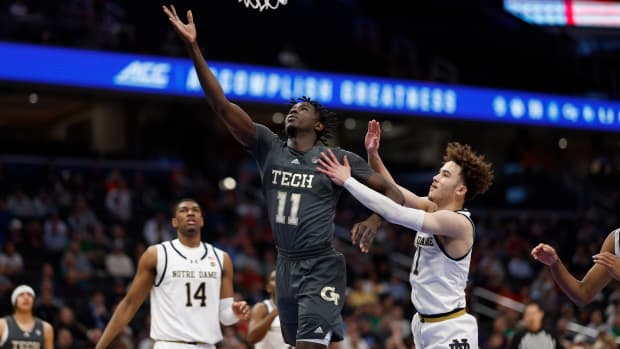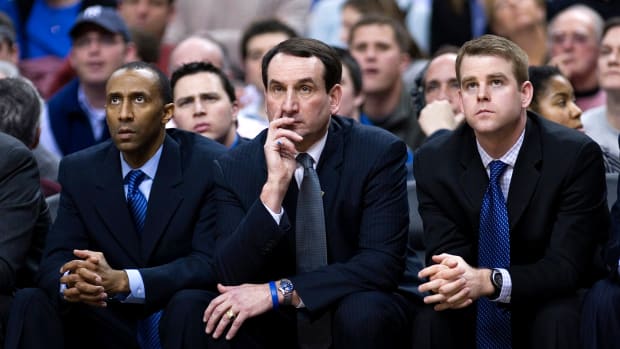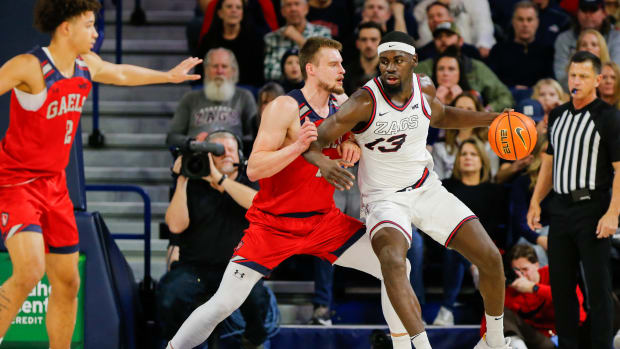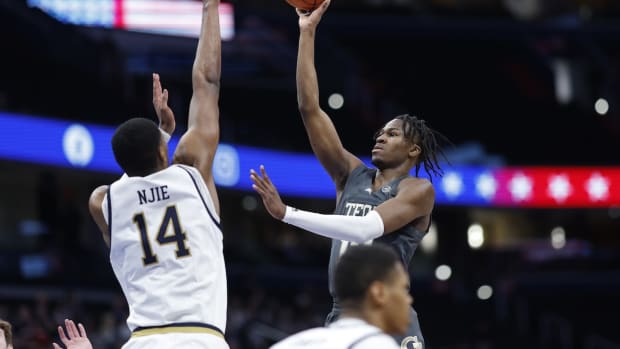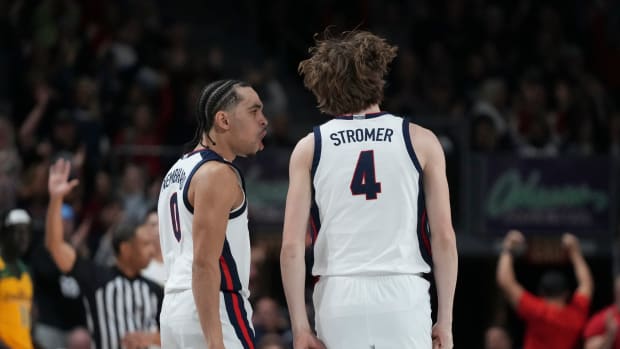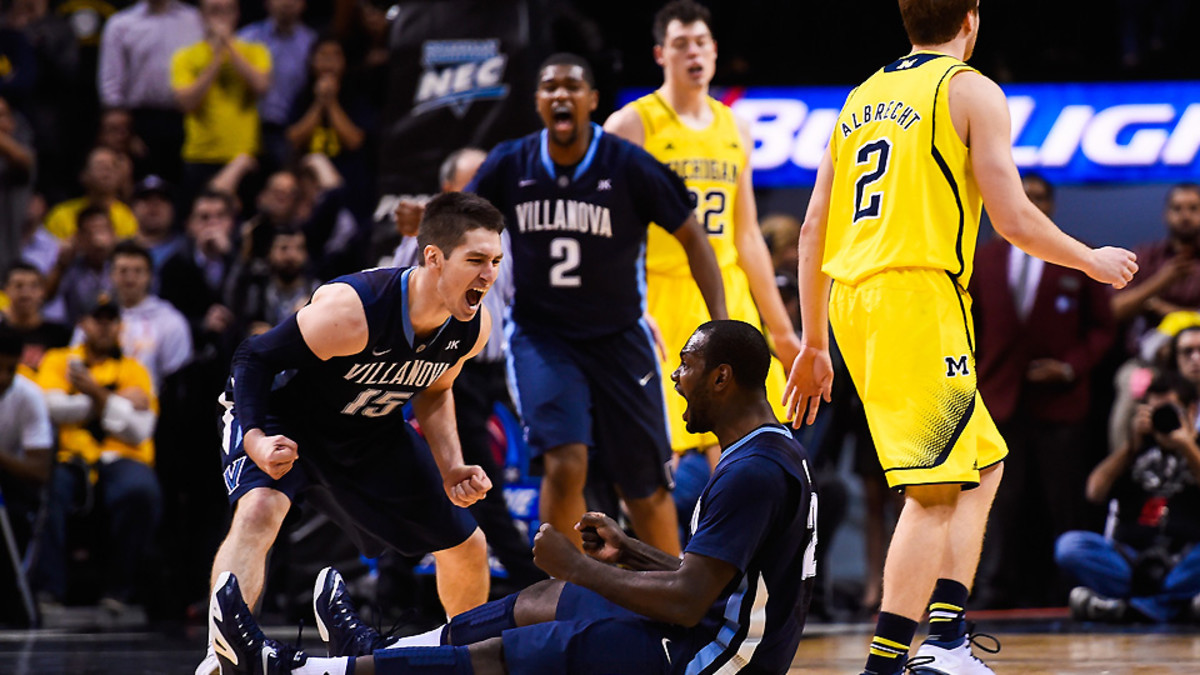
Big East embracing identity, showing strength in non-conference play
On Tuesday morning, Val Ackerman hopped on the subway and hustled to her office in Manhattan to avoid the rain and wind afflicting most of New York. As a nor’easter blew through, the room provided welcome refuge. Outside, it was miserable. But within the Big East commissioner’s walls, there was sunshine and glee.
“I think we know it’s a long season and it’s still early,” Ackerman said, “but we’re very happy.”
Happiness, it seems, is seeing one of the league’s teams beating North Carolina. And Oklahoma. And Syracuse. And Michigan, Illinois, VCU, Minnesota, Nebraska, Florida and Notre Dame. Yes, there have been stumbles. But the failings are obscured by these remarkable wins, the headline triumphs for a league that has won 78.8 percent of the time it has played outside competition and has the nation’s second-best conference RPI. In its second year of a reconstituted existence, it’s not so much that the Big East is back. It’s acting like it never left.
When these 10 schools assembled to forge basically the only basketball-fueled conference going, it created a simple imperative for viability. The Big East could not exist on the hoops margins. It couldn’t be the cute little mom-and-pop operation on the corner. And even if it looked a little like a mom-and-pop shop, it had to be the one selling black-market firepower from a back room. It had to be tenacious enough to play the high-profile teams from the power conferences and then it had to win as often as possible.
“If you’re going to go at it alone -- and we are, we’re out on an island -- it’s important to be successful,” Villanova coach Jay Wright said. “It’s something new, so we know we’re kind of out there, trying to prove ourselves. It’s kind of funny, with the schools that have the basketball traditions that we do. You go out and you make that statement and you make that commitment, you have to prove yourself. We do feel rejuvenated and excited by it. And we root for each other. Then when we play during the season, we want to kill each other. It’s pretty cool.”
• CBB Power Rankings: Villanova leads Big East at No. 6
A 12-year television contract with FOX ensured visibility and stability. It did nothing to guarantee the quality of what you saw on the screen. Nor did it immunize the Big East from the standard year-to-year personnel transition that can undercut any program. That’s of course a challenge faced by any league. But the Big East is in a more delicate spot, one in which Doug McDermott’s graduation from Creighton or Butler’s unexpected coaching transition can create significant drag. McDermott gave the league its anchor for its debut season. Being unmoored is not what the Big East needed to be in year two.
Winning, and especially winning a lot against peer programs, quells those worries. The league should have everyone’s attention now. “How conferences are going to be judged in any sport, whether it’s football or basketball or soccer, is going to be how they perform at a national level,” Ackerman said. “We’re confident that the Big East will continue to compete at the highest level nationally in basketball. That’s why this group of schools came together.”
How did this particular season come together? It’s a mix of meeting and exceeding expectation, with some atonement for last year sprinkled in.

Val Ackerman and Big East teams felt pressure to win this season after disappointing NCAA tournament results last year.
Bloomberg via Getty
Eight of the Big East’s 10 teams lost 12 or more games a year ago. Four teams earned NCAA tournament bids, but none advanced to the Sweet 16. It wasn’t a horrible start, but it wasn’t exactly resounding, either. “Last year, all of us in some way felt some responsibility for a little bit of a down year,” Wright said. His program was likely to do its part to rectify matters, after winning 29 games a year ago and bringing just about everyone back. And the Wildcats have followed through, sitting at 9-0 with wins over VCU, Michigan and Illinois.
It’s the perceived middle-to-bottom-tier teams that have reared up, pushing the Big East to the No. 2 conference RPI, according to RealTimeRPI.com. Creighton (8-2) has wins over Oklahoma and Nebraska, the latter coming on the road. St. John’s downed a Syracuse team in transition. Providence notched a win over Notre Dame and even DePaul knocked off Stanford. Granted, the Friars are saddled with a three-game losing streak that includes a double-digit loss to Brown. And the Blue Demons have a 12-point loss to Lehigh on their ledger. And Seton Hall didn’t truly threaten Wichita State on the road this week. And Georgetown has lost two showdowns with top-10 teams (Wisconsin and Kansas) by a combined eight points. But there’s enough evidence of competitiveness to legitimize the league and its depth.
There’s also Butler, which is 8-1 and ranked No. 15 with wins over North Carolina and Northwestern under interim coach Chris Holtmann -- not to mention the odd non-conference win against Georgetown in the Battle 4 Atlantis. The Bulldogs’ recovery from a dismal 2013-14 season and coach Brandon Miller’s leave of absence has been a Big East boon. And Butler still has upcoming games with Tennessee and Indiana.
The grind is emblematic of the scheduling “point of emphasis” Ackerman delivered to her programs, which was more a reminder than direct order: Big East teams must undertake high-profile non-conference challenges in order to keep the league relevant and healthy. “Our coaches know games they play in January and February and March are going to be very competitive, so they know they need to challenge themselves early on to get ready for that,” Ackerman said. “Secondly, we do have our sights set on a high level of representation in the tournament and we know the quality of schedule is a component in that. It’s not just about wins and losses. It’s about quality wins.”
Quality wins, the league has. If there’s a question, it’s how often this non-conference success bears repeating.
This year’s run is this year’s run. The Big East might have to keep doing this every November and December for a while to prove its potential.
• CBB Bracket Watch: Villanova a No. 2 seed in our first projections
“Even if we all finish with a great year this year, it’s consistency -- that’s what all the great conferences have,” Wright said. “How this plays out, the way I see it, we could have a league that five or six teams every year are competing for an NCAA tournament bid -- if you got a league that’s getting 50 to 60 percent of the teams in every year, that’s a hell of a conference.”
This year, though, optimism over the non-conference achievements is buoyed by the Big East’s attempts to fix conference play. By the time the league had its commissioner last year, the scheduling process was underway, and FOX was in charge. Gripes from the league’s coaches about late weeknight start times or odd turnarounds -- like Sunday-Tuesday games, for example -- ensued.
Wooden Watch: Kaminsky, Okafor remain on top as Harrell rises
For this winter, Ackerman said the league worked “very hard” with FOX on these issues and that its television partner responded “very cooperatively.” There are 20 weeknight 9 p.m. tipoffs on the Big East slate; only 10, are cross-region trips that will make for some near-dawn charter flight landings. (Villanova at Georgetown at 9 p.m. ET is maybe not ideal, for example, but at least it’s a quick hop for the Wildcats back to Philadelphia.) “You wan to make sure it’s fair, as fair as you can make it,” Ackerman said. “Scheduling is very difficult, one of tougher jigsaw puzzles out there. It doesn’t make for perfect scheduling for everybody, but we worked very hard this year to make it better and improve it. I think the schools are much happier. They seem to be.”
On top of everything, the Big Ten announced this week it would hold its league tournament at Madison Square Garden in 2018 -- but a week earlier than usual, because the Big East didn’t budge from contractual first dibs on the venue. The wins against football-backstopped conferences are coming in every way, it seems. It’s a dynamic that reminds Wright of his days as a Villanova assistant in the late 1980s, when the Big East was a relatively small league with incredibly competitive basketball and incredibly competitive personalities leading the way. “Everybody took great pride in everybody’s success,” Wright said. “As the Big East grew, we kind of lost that. But now I feel that same pride amongst these schools. We’re basketball schools. In this era of football, we’ve kind of taken a stand that we are what we are. We’re metropolitan-area basketball schools, basketball is our No. 1 sport, and we’re going to try to go it alone. I can see everybody takes real pride in it.”
So far, anyway, the Big East has given itself good reason to do so.
